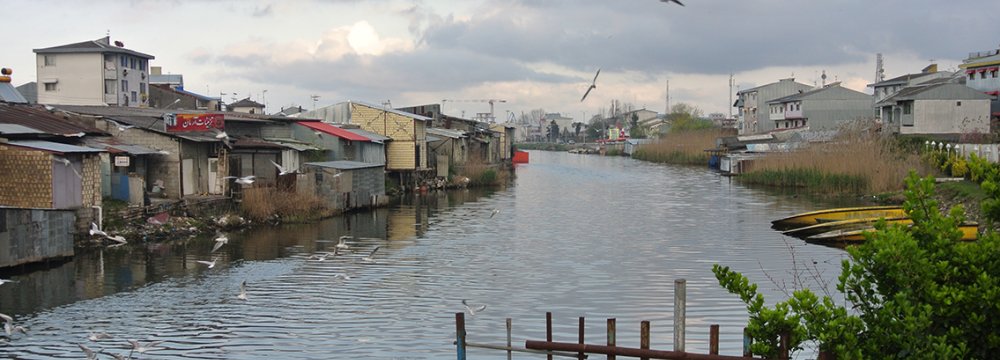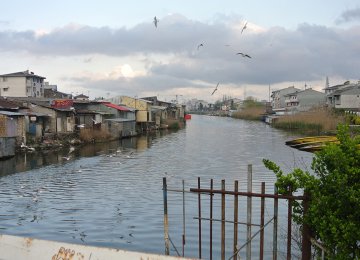As we continue our series on different free zones around Iran, in this latest installment we will discuss the prospects of Bandar Anzali Trade-Industrial Free Zone located on the northwestern shores of the Caspian Sea. Anzali, as it’s more usually known, is seen as a destination to visit and trade in by Iranians wanting to access Caspian Sea surrounding countries. The port also has the added advantage over its Persian Gulf counterparts of amicable weather throughout the year with temperatures topping the late 30s in the summer and hovering above zero degrees centigrade in the depths of winter.
Bandar Anzali has the most active port on the northern coast with an annual capacity of 7 million tons of cargo within its area. The Anzali free zone’s website states its strategic geographic position as the only free zone in relation to the Northern Caucasus and Caspian region, which like other free zones in the country, allows visa free entry and exit for foreign investors and tourists and 20-year tax exemptions for investors. The port is also one of the newest locations for Iran’s Mercantile Exchange with a new trade floor opening in the port city last year. In addition to the prior points, Anzali free zone states it allows 100 percent foreign-owned enterprises in the area and that registration is a quick and easy procedure. Recent government statistics show that the zone exported 258,000 tons of goods worth in the region of $142 million from the port in the Iranian year ending March 20, 2014; analysts suggest the figures for this year will exceed the previous year by a large margin.
Recent Developments
Back in August Anzali Trade-Industrial Free Zone Organization inaugurated its first official commodities exchange hall in the port. The opening was attended by government officials and the managing director of the zone. The first transaction occurred on August 23 with 20 tons of sulfur from the Tehran Refinery and 1,500 tons of polyethylene from the Maroon Petrochemical Company. The head of the IME, Hussain Panahihan, said on the day, “We’re appreciative of Anzali Port for setting up the satellite office of the IME at the port,” adding that the opening of the new exchange would open up the northern region and place it in the strategic position in promotion of trade transactions of Iran with CIS (former Soviet states) countries.
He went on to say that with the new exchange opening, business would become more competitive in the region, allowing market mechanisms like price discovery to take place when realizing prices of commodities being traded on the site, adding that, the import of goods takes the lion’s share of trade transactions in the free zone, which will in turn help Iranian manufacturing.
The port has also attracted much foreign interest in recent months, with the government in Tehran actively backing foreign ownership in the site. Last week, Reza Masrour, managing director of the free zone organization said he and other top officials were in discussions with businessmen from neighboring Azerbaijan to put money into the zone, saying, “Iran is now offering large tax breaks for foreign companies wishing to enter the site.” He also said there are no tax and duties for raw materials and machinery imported for production.
The Russian Connection
Recent developments about Russia’s ongoing conflict with the European Union and the United States over the conflict in Ukraine have raised expectations in Iran of new exportation from the free zone. Moscow has announced in recent months that it is actively looking at Iran as a new major trade partner for many goods including foodstuffs among others. This is due to the European Union sanctioning Russia for its alleged involvement in the neighboring Ukraine. In response to the economic sanctions, Russia hit the West with ban on their products. Russia’s decision to impose a food embargo in response to Western sanctions may cost the European Union €5 billion ($6.6 billion) a year, according to an internal EU document. In the light of the current argument between the two economic giants, Iran through Bandar Anzali is likely to export more than ever to Russia.
On September 30, Russia and Iran announced they were planning to replace the US dollar with their own national currencies for the settlement of bilateral trade transactions, IRNA reported.
Announcing the plan at a meeting in Tehran last week, Asadollah Asgaroladi, an Iranian business head of the Iran-Russia Joint Chamber of Commerce, said that use of national currencies would spur economic collaboration between the two countries. This announcement by the chamber director followed another agreement between the Iranian and Russian energy ministers, who also agreed to trade in their respective currencies.
The new wholesale agreements between Tehran and Moscow will in turn lift Bandar Anzali and the free trade zone to a new level of prominence. As trade ties between Russia and Iran continue to open up the role of Anzali as a center for international trade will only increase.
Transport Connections
Anzali Free Zone will also benefit from other types of transport investments in upcoming months. On September 19, Road and Urban Development Minister Abbas Akhoundi reiterated the government’s willingness to expand railway connections with neighboring countries with the completion of the Qazvin-Rasht-Anzali-Astara railway. This route, once completed, would also speed up transport times between Anzali Port and CIS countries.
Akhoundi stated that the development of the Iran-Azerbaijan rail link will take several years to complete, and in the meanwhile short term measures can be implemented to speed up transaction via Anzali Port train terminal. He also said that Iran has now commenced plans to construct a new 40 kilometer railway section between Anzali and the northern city of Rasht. This new connection would enable imports of goods through Anzali to be transported by railway to Persian Gulf ports overland via a direct train route.
In the long term, more railway connections will be developed from Anzali, with the Turkmenistan’s section of the Iran-Turkmenistan rail link already completed. The Iranian section will be connected in a short while. The track at a later point will connect all the way up to Kazakhstan and China considerably shortening times of transport to ports like Anzali.
To conclude, Anzali is not likely to become a touristic destination in the short term – though it has many considerable attributes like wetlands and wildlife, but it is likely to become the southern Caspian Sea’s most valuable port. With its increasingly complex array of transport connections going far and wide, along with its free trade-industrial zone status – an incredible offer to any of the countries on the peripheries of the land-locked sea, along with future Russian and CIS trade links, Anzali’s future is looking more positive with every passing year.





